March 31st, 2010
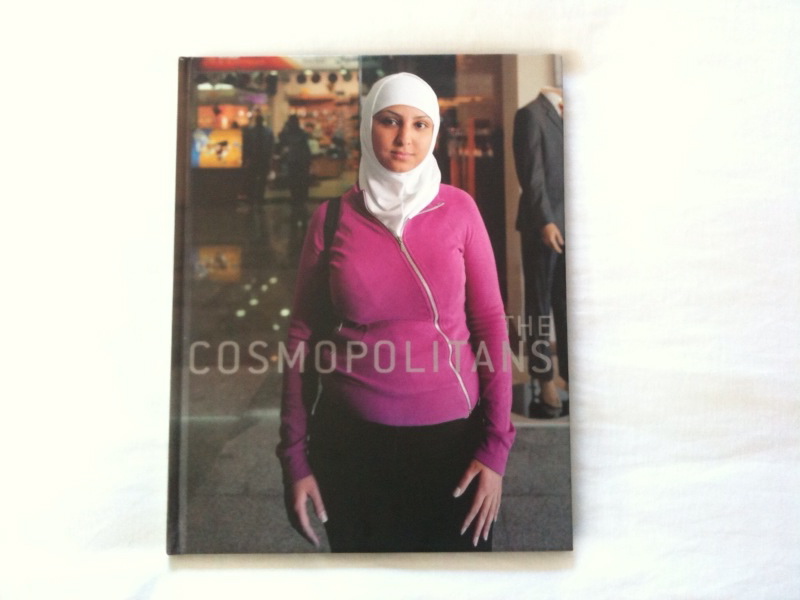
The Cosmopolitans
Photographs by Zubin Shroff
Introduction by Ella Shohat, Robert Stam, and Zubin Shroff
Veenman Publishers, 2008
9.75 x 12.5 in. / 96 pages
Zubin Shroff‘s portraits are beautiful. I want to live within the world of his book; a world that is diverse, open, and equal. Even though the photographs are from six different continents, the series seen together in book form makes all borders, language barriers, and culture barriers disappear.
In The Cosmopolitans, photographer Zubin Shroff places his formal, studied portraits in the liminal spaces where our rapidly advancing global culture is continually being shaped. In doing so, Shroff questions the notion of cosmopolitanism and challenges the way in which we perceive each other and who we may consider a global citizen. Photographed on six continents, the portraits include Shroff’s family and friends alongside pilgrims, artists, construction workers, and actors from both Bollywood and Hollywood. Shroff includes his own self-portrait, locating himself as both the author of the work and a denizen of the changing world he is depicting. Shroff titles each photograph with only the subject’s name, deliberately provoking the viewer by removing both the geographic and cultural signifiers that often accompany such imagery. Eliminating these anchors allows us to imagine ourselves both inside and outside the context of the photographs, and creates a space where we are able to appreciate the individuality of each person and the larger relational possibilities of the group as a whole. By extension, we are invited to reconsider the meanings of global borders and the roles of these new “Cosmopolitans” in crossing and thereby erasing those same borders. The photographs are accompanied by a conversation with New York University (NYU) professors Robert Stam and Ella Shohat that expands the discussion of global citizenry, as related to the context of, post-colonial history the power of media the concept of “home,”, and a wider analysis of today’s polycentric world. – Publisher’s Description
It looks like photo-eye has a few signed copies of this out-of-print book.
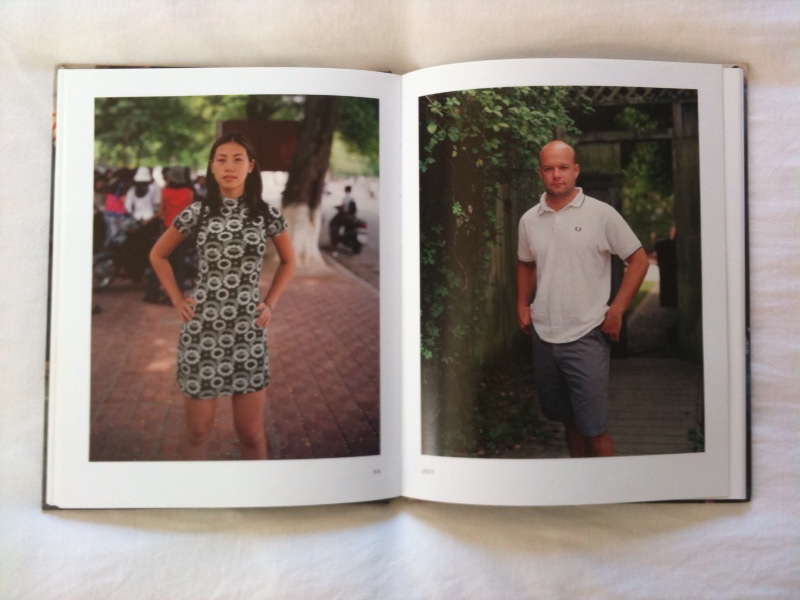
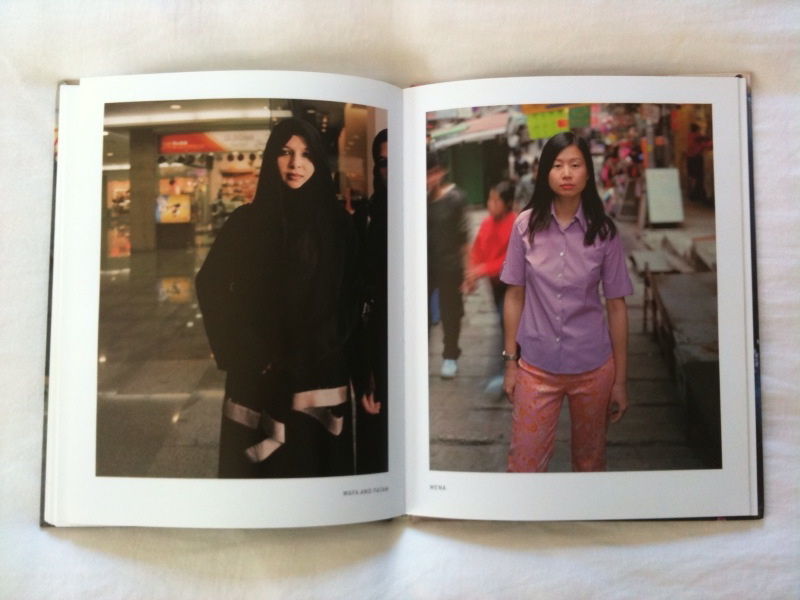
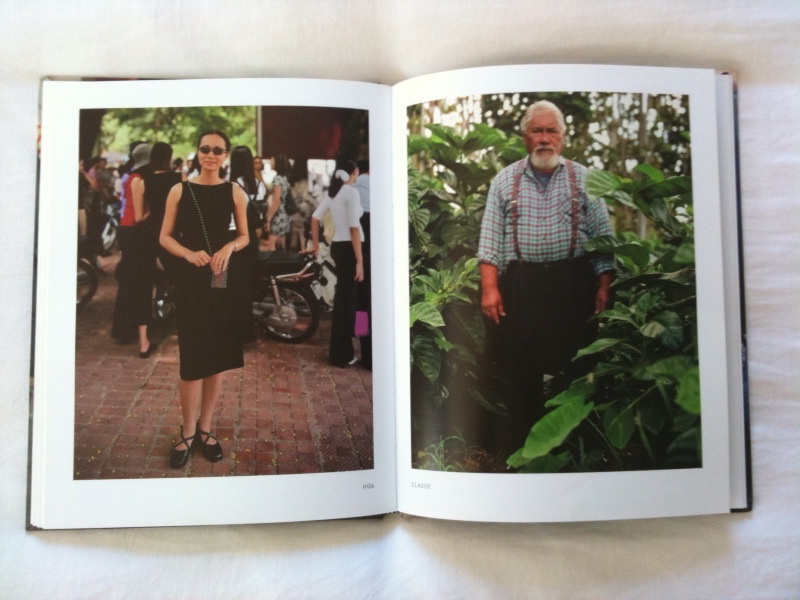
March 26th, 2010
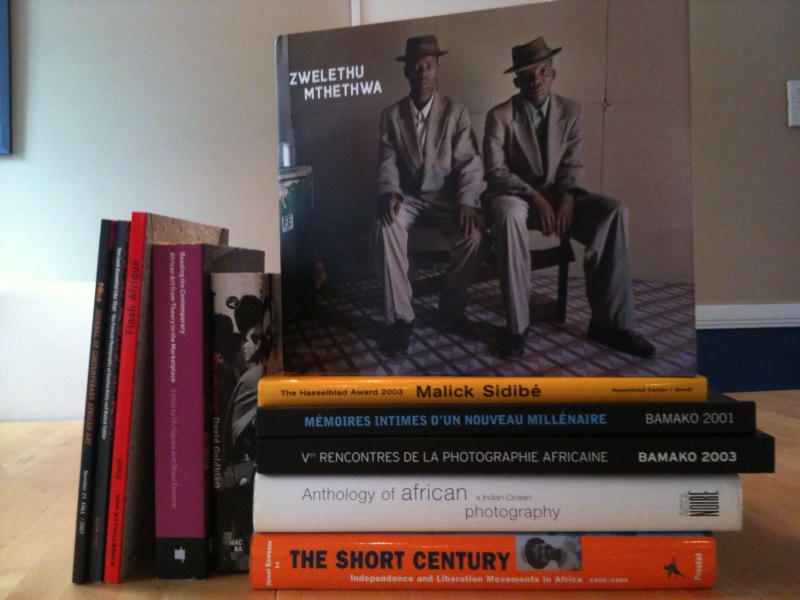
a selection of books on African photographers/photography
I just received my review copy of Zwelethu Mthethwa’s monograph published by Aperture. So excited! This is his first monograph and a monograph I have been waiting for for years. Joerg Colberg recently reviewed the book on his blog Conscientious and my review will be published by photo-eye. Colberg, or anyone for that matter, should definitely not be looking at traditional media for guidance in learning about the nuances, diversity, vibrant culture, art, and photographic discourse of Africa. About the monograph he said, “I really hope that Zwelethu Mthethwa will not be the last book of its kind, showcasing photography done by African artists. We need to see more.” I agree, in the sense that we need more monographs. Where are monographs for Lolo Veleko and Philip Kwame Apagya for example.
My interest in contemporary African photography developed in graduate school. Okwui Enwezor is my favorite curator. Half of my photography collection is dedicated to African photographers and I have a wide range of books on African photography. In light of Colberg’s search and a recent #photohistory discussion on Twitter, I wanted to offer a partial list of books dedicated to African photography from my library – a good place to start for anyone interested in this history of photography.
Snap Judgments (ICP/Steidl, 2006)
Rencontres Bamako 1998, 2001, 2003, 2005, 2007, 2009
Anthology of African & Indian Ocean Photography (Revue Noire, 1998)
In/sight: African Photographers 1940 to the Present (Guggenheim Museum, 2003)
The Short Century (Prestel, 2001)
Flash Afrique! Photography from West Africa (Steidl, 2002)
You Look Beautiful Like That: The Portrait Photographs of Seydou Keita and Malick Sidibe (Harvard Art Museum, 2001)
Africa Inside (Noorderlicht, 2000)
Malick Sidibe: Photographs (Steidl/Hasselblad Center, 2004)
J.D. ‘Okhai Ojeikere Photographs (Scalo, 2000)
Fifty-One Years: David Goldblatt (Actar, 2001)
“Talk of the Town: Seydou Keita” by Manthia Diawara in Reading the Contemporary: African Art from Theory to the Marketplace (MIT Press, 1999)
Nka: Journal of Contemporary African Art
and of course Zwelethu Mthethwa (Aperture, 2010)
And you can read about James Pomerantz’s class on African Photography on his blog A Photo Student.
I would love to hear from anyone about this subject. Please get in touch if you are a photographer, curator, writer, scholar, etc. I am specifically interested in what material/photographers are out there from East Africa.
March 20th, 2010
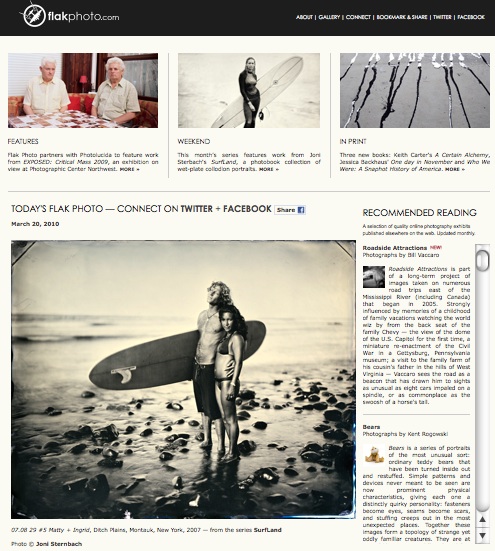
FLAK PHOTO: WEEKEND series: SurfLand by Joni Sternbach
Throughout the month of March, Flak Photo, in its WEEKEND series, is featuring photographs by Joni Sternbach from her monograph SurfLand. (Check out each weekend image: MARCH 6, 13, 20, & 27, 2010.) Joni embraces the difficulties of using a large format camera and the wet-plate collodion process in a windy and sandy ocean environment to create these one-of-a-kind stunning portraits of surfers. In the midst of AIPAD, I talked with Joni and asked her what impact being a Critical Mass winner has had on her as a photographer, her audience for this work, and about her connection to water and historical photographers.
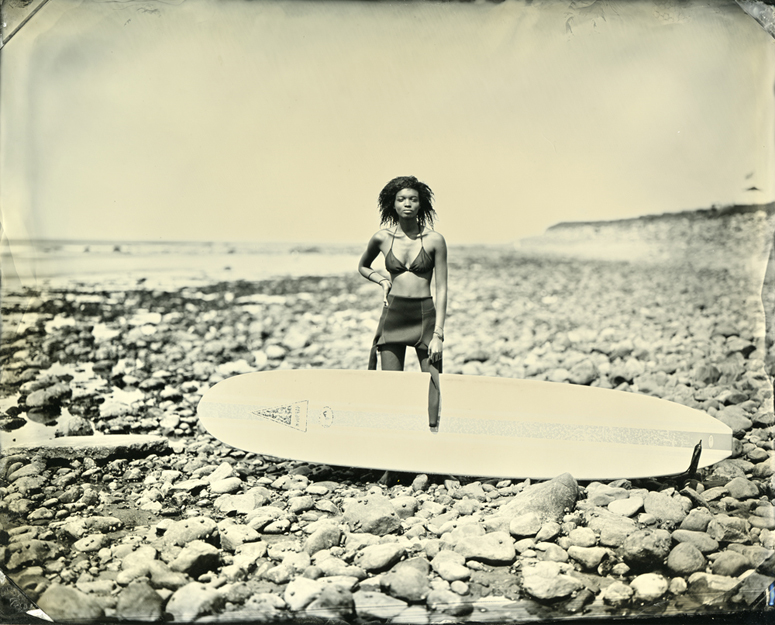
07.07.02 #7 Lily. 8" x 10" unique tintype. Ditch Plains ©Joni Sternbach
Larissa Leclair: In 2007 you were a Critical Mass winner along with Peter van Agtmael. What kind of impact did that award and the resulting monograph SurfLand, published by photolucida in 2009, have on you and your work?
Joni Sternbach: Winning the Critical Mass book award had a huge impact on me, and really changed my life as a photographer. I think it grounded me in the world of photography and gave me a place that I didn’t have prior to it. Also, having the book showcased my work and gave it more visibility, which I believe opened the door to the solo show at the Peabody Essex Museum in Salem, Mass. Books are circulated in a completely different kind of way than artwork is in a gallery or on a website, or in any of the other ways photographs travel around the web these days. The book is a tangible object and the work is interpreted through that format. I think books are a beautiful medium. They lend a certain narrative to the work that my individual plates might not convey. Not only did the book add to my marketability as an artist, it gave me a forum for my work that it didn’t have before.
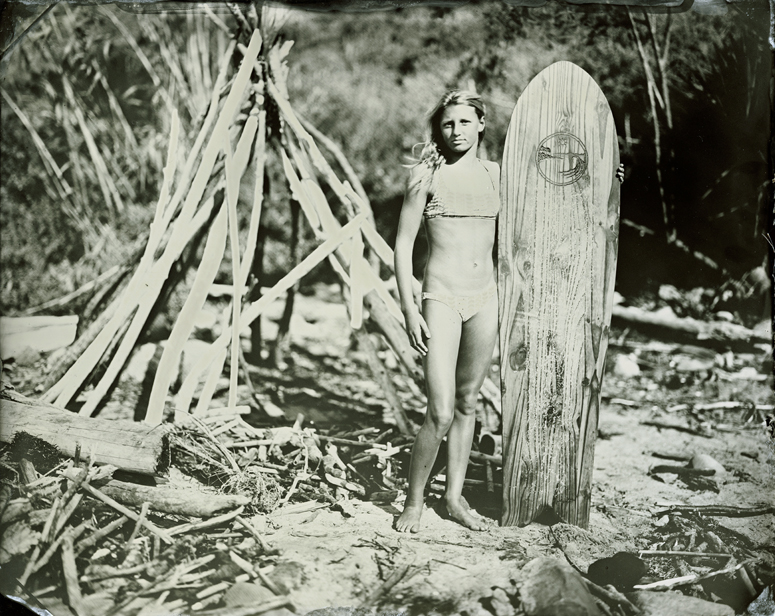
09.02.12 #8 Lakey. 8" x 10" unique tintype. Rincon ©Joni Sternbach
LL: The exhibition “SurfLand” at the Peabody Essex Museum in 2009 launched a regular schedule of photography exhibitions at the museum. Phillip Prodger is the first curator of photography at PEM and also the essayist for your book. How did you come to know Phillip and how did this harbinger exhibition come about? What an honor!
JS: I first got to know Phillip Prodger when he was Assistant Curator of Photography at the St. Louis Art Museum. I sent him a show announcement and he liked the work and wanted to consider it for an exhibition he was curating on landscape photography. This led to a period of communications that spanned many years. He later left the museum, curated independently, but his successor ended up using my work in that landscape show. When Phillip went to the Peabody Essex Museum, we connected again and I brought him some of my surfer tintypes. Seeing the actual plates was the decisive moment in his suggestion to propose a solo show. By this time, I had won the photolucida book prize and because I admired his work I had already asked him to write the essay. So it all came together in this very perfect way. The book then acted as a catalog to the exhibition even though it was not produced for that specifically.
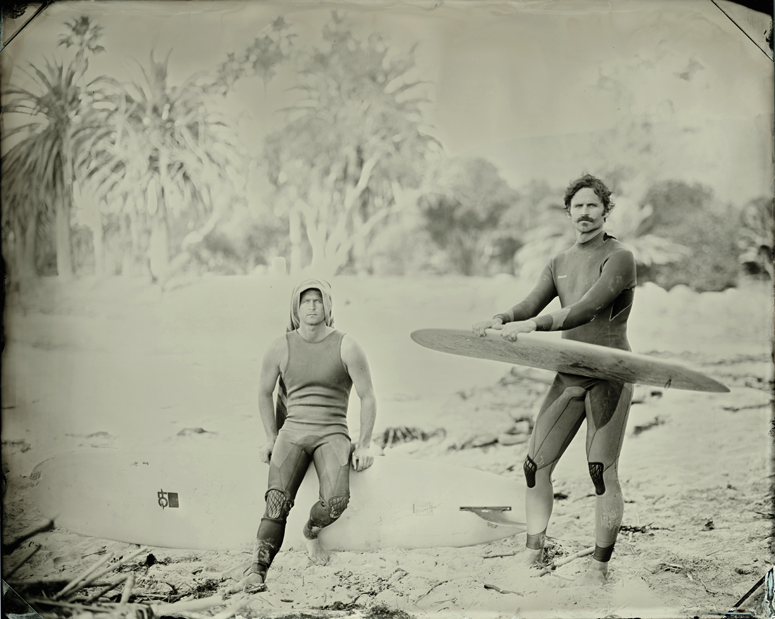
10.02.17 #5 Chris & Dan. 8" x 10" unique tintype. Refugio ©Joni Sternbach
LL: I would imagine that your audience for tintype photographs would be completely different than the audience for photographs of surfers. This work has appeared on the cover of PDN in the context of historical techniques (October 2009) and also in surfing magazines. I’m not sure what my question is… I find the juxtaposition of these audiences interesting. The broad audience that this work resonates with is great. I wonder if you have any stories related to this audience mixing.
JS: Although they do seem like disparate audiences, strangely enough, I think these two groups connect. On one hand there are the people interested in 19th century photography who collect tintypes and daguerreotypes, and then there are the surfers. Photographing on the beach is a performance of sorts and many people are drawn to the large format wooden camera and then to the photographs as I am making them on location. Being able to see the finished product right there on the beach is central to my project. The reason these two groups mix is because many surfers are photographers and some are artists or they are involved in creative fields. One surfer that I met on the beach and photographed, was also a designer. A few years later he opened up a hotel in Montauk called Surf Lodge, and he wanted all varieties of surf photography for decoration. He bought 4 of my photographs, depicting some of the local people in Montauk who are well-known as surfers and who also have a reputation in the art world. So there is this mix between the art world and surfing.
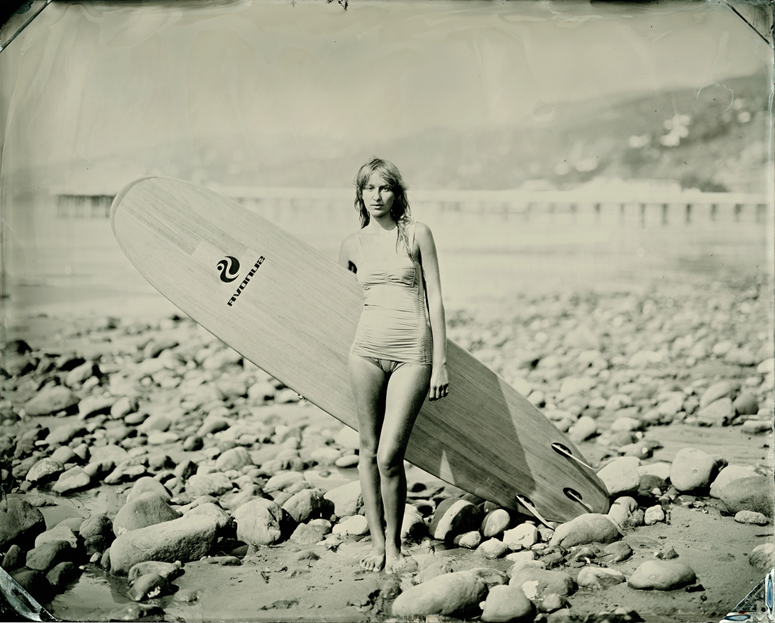
10.02.08 #5 Hannah. 8" x 10" unique tintype. Malibu ©Joni Sternbach
LL: Do you continue to add to the “Surfers” body of work or is it a finished project?
JS: I am still working on it. I was just in California for two weeks in February continuing the project. There is a certain magic that gets generated by being out there on the beach and making these pictures – connecting with people in a very random way. Often times I just go to a beach where I don’t know anybody, introduce myself, and take pictures of people who happen to be surfing there. Other times I have a planned meeting with one person or a group of people. Sometimes, they are complete strangers. What I want to convey to you is this incredible encounter that happens when I meet these people and make pictures on the beach that transcends photography. It’s about chance and it’s about spontaneity. It’s not about control, but rather letting go of it. It’s about intuition and allowing the interaction to develop solely because you are in a certain place at a certain time. That is something that I love. I am working on other projects as well now but I don’t feel like I have finished with this project.
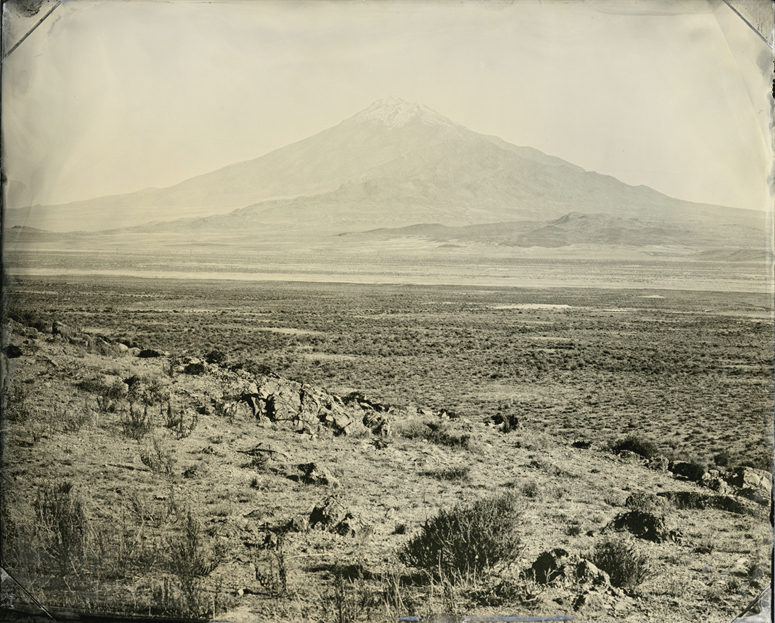
08.04.13 #7 Pilot Peak 8x10 unique tintype ©Joni Sternbach, from "The Salt Effect" series
LL: Everyone asks you this question, “Why tintype?” I’m going to you ask you a bit differently. I’m wondering if you are interested just as much in the process and ritual and the physical art of making the tintype as in the final feel and quality of the finished photograph. Does it connect you personally with certain historical photographers and methods of the past?
JS: It’s true, I get asked this question all the time. One of the things I am trying to do, is to use the medium of collodion (tintype, ambrotrype, negative) as a valid contemporary tool. I relate to it as a choice in photographic medium the same way that large format represents a valid choice over 35mm or even film versus digital. To me it is yet another tool in the history of photography that people are paying more attention to now because photography has taken a digital turn. Making hand-made objects is a way for me to be self-reliant from the marketplace and is a really satisfying photographic process. My tintypes are one-of-kind and made in-camera. So that is one of the reasons. As I’ve described, the act of making the photograph on location is something that involves my subjects as well as myself. So when I am out there taking the picture and processing it and then fixing it in daylight, my subjects are watching as I am doing this and they are just as excited and thrilled by the result as I am. And that engages them and it also encourages other people to participate in the project. It is live performance: I am making art in public. It involves camera work, chemicals, and people.
19th century photography has had a huge influence on me, though in the “SurfLand” series, I am using a 20th century camera and 20th century lens. I have opted out of using antique brass lenses without a shutter. I am not trying to recreate a 19th century aesthetic. But I am interested in the way 19th century aesthetics inform photography and inform my work.
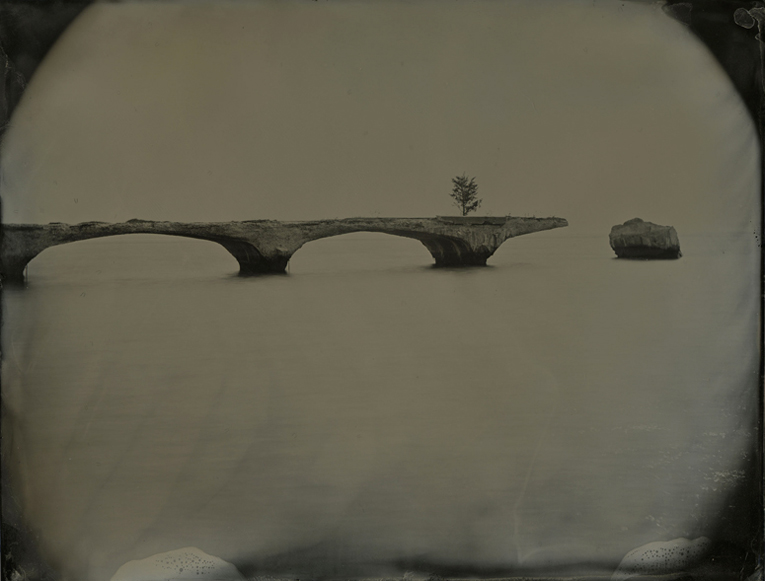
05.10.31 #5 6.5" x 8.5" tintype. Broken Bridge, Shelter Island ©Joni Sternbach, from "Abandoned" series
LL: I have recently been researching Muybridge for the major retrospective at the Corcoran and I keep thinking of Muybridge when I look at “The Salt Effect” and “Abandoned.” He photographed the expansion of the railroad in Utah, an example of progress that in the modern day has effected the landscape there. And in “Abandoned” you are photographing the antithesis of “new-world progress.” Can you talk about these two bodies of work in relation to history?
JS: It’s really interesting that you mention Muybridge whose work has been very influential. In a previous body of work, not on my website, is the series “Untitled Silhouettes” from the early 90’s. It is a group of silhouette portraits of women modeled after Muybridge’s study of the human figure in motion. The prints are made in platinum-palladium from Polaroid negatives in two sections that are pieced together. I was completely interested in the way Muybridge used the figure in scientific study. His models are naked and the women are holding objects associated with domesticity while the men are holding things related to masculinity or sports. I made this entire body of work in dialogue with Muybridge, so it is interesting that you mention him.
The series “Abandoned” was my first body of work using collodion. My foremost concern was scouting locations close to or directly on the water, searching for the mystery of an abandoned past. Structures and places that have lost their functionality are now emblematic of a more primitive time. They represent the last stand, the human effort most poignantly seen through decay and the return to nature. So I like your phrase “the anti-thesis of new world progress.” Westward expansion and the birth of photography happened simultaneously. As an Easterner I did not have the same physical connection to the west as people who live there. Going to Utah was my first Western landscape experience. I didn’t believe the literature that said this was not the “romantic west.” They even warned me the weather was on steroids. When I got there, it was cold. It was windy and it was really difficult to make pictures in those conditions. I had brought along film as well, so I did a combination of wet-plate and film shooting that was an investigation into understanding the implications and effect of salt on the environment. What I didn’t know when I got to Utah was that I was going to be surrounded by an invisible body of water, with all the salt beds there, so it was the opposite of where I had been photographing along the coast line. Of course there are contemporary artists, such as Mark Ruwedel’s Westward the Course of Empire and Mark Klett, who have this connection and who have been working on the West for years. But for me, it was all completely new.
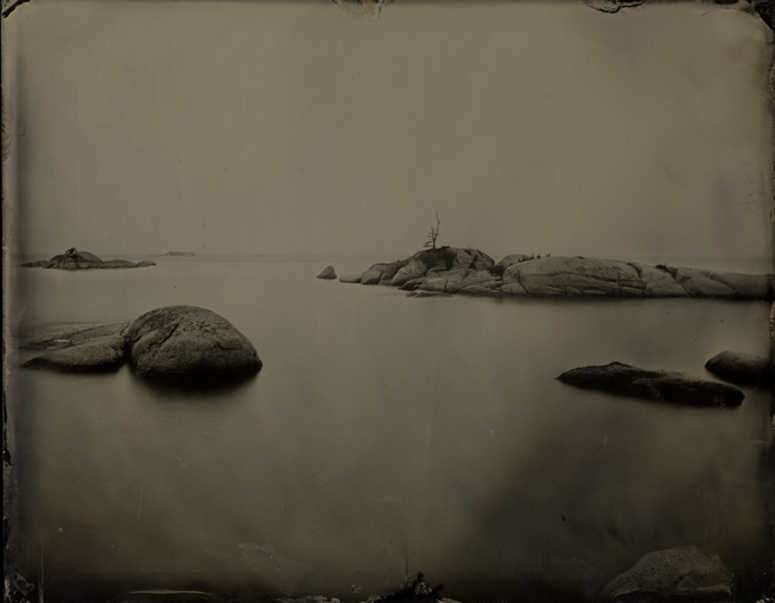
05.10.07 #1A. 6.5" x 8.5" ambrotype. Deer Isle ©Joni Sternbach, from "Abandoned"
LL: With the longer exposure time for the wet-plate process, water is captured as a magical surface, an element in your photographs that I absolutely love. You focus on it in “Ocean” and “Sea/Sky;” it grounds your surfers; takes on its own life in “Abandoned;” and then is referenced in “The Salt Effect.” What is your connection to water?
JS: There is an intuitive pull for me. I grew up around the ocean, and had the ocean as a destination. I spent time as a kid with my grandmother in places like Rockaway and Long Beach. That is my early connection. It is a place I feel I must be close to. I love to swim in the ocean. I feel it is a primal source. I love its cyclical nature and its timelessness. The beach is a place where we can exist in some other time frame and for me, it is a complete escape from the “dressed-up” lifestyle required in the city or at work. I do think that photographing water allows us to think about time and time passing. The photographs capture time or slow it down, giving the water a quality that’s hard to imagine without the medium of photography.
LL: Thank you Joni.
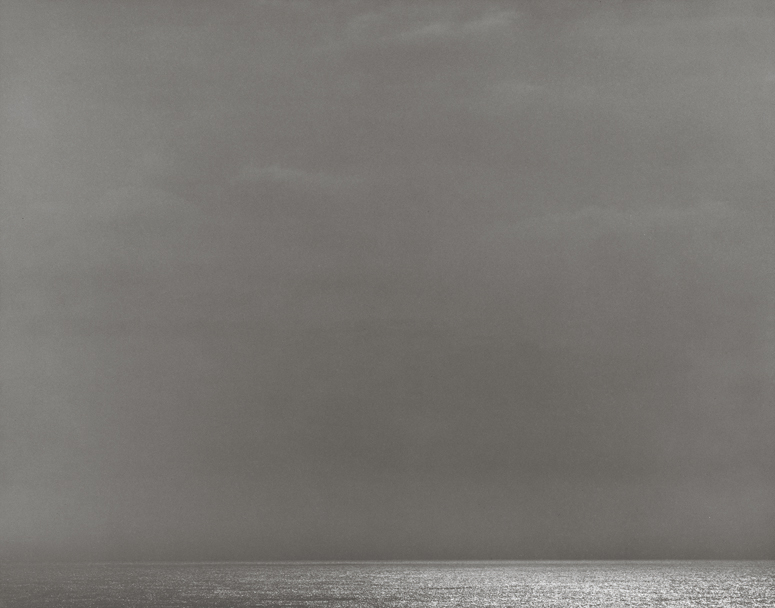
02.02.17 #1A ©Joni Sternbach, from "Sea/Sky" series (silver gelatin)
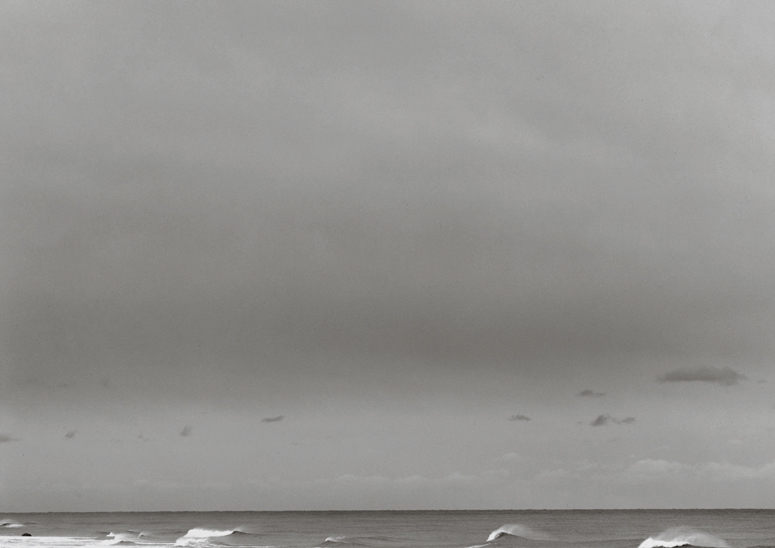
01.11.22 #1 ©Joni Sternbach, from "Sea/Sky" series (silver gelatin)
Learn more about Joni Sternbach on her website. Joni Sternbach is represented by Joseph Bellows Gallery, Edward Cella Art + Architecture, and Kenise Barnes Fine Art.
Her monograph Surfland, published by photolucida in 2009, can be purchased here.
Additional interviews with Joni Sternbach:
March 18th, 2010
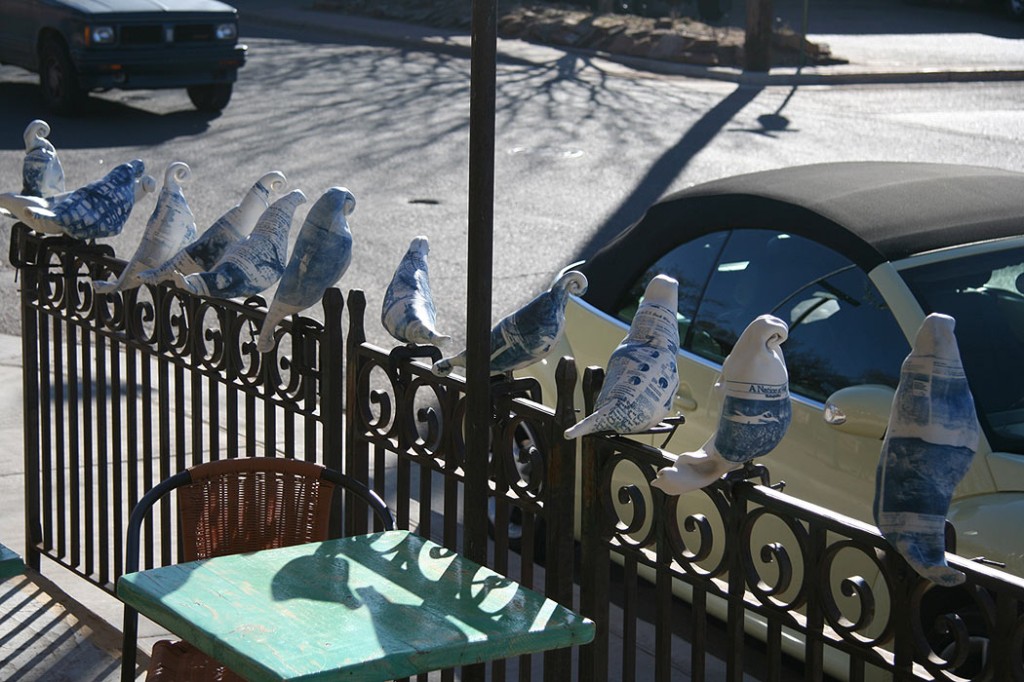
Native Washingtonian Christy Hengst is back in DC today with “Birds in the Park,” a temporary art installation that is both an exhibition and an event (March 17-21, 2010). Starting today, catch her porcelain birds on the National Mall at 9th Street. They will be “flying” to Dupont Circle tomorrow and then Upper Senate Park on Sunday, March 21. The birds have been on a world-wide tour starting in Santa Fe, New Mexico and “landing” in California, New York’s Central Park, Germany, France and even the Galapagos Islands. With this project Hengst investigates aspects of humanity, specifically around war and peace, and asks viewers to do the same. After DC, the birds travel to Amherst College, Amherst, MA; the Brattleboro Museum and Art Center, Brattleboro, VT; the Hudson River Waterfront, Peekskill, NY; and the Hammond Museum and Japanese Stroll Garden, in North Salem, NY.
A complete schedule of “landings” can be found on Christy Hengst’s website and you can follow the birds on her blog.
The project is sponsored in part by the Environmental Film Festival, International Arts and Artists, the Washington Peace Center, and the DC Commission on the Arts and Humanities.
A documentary film is being made about the project. Genevieve Russell of StoryPortrait Media will be in town documenting the “landings.”
Christy Hengst was interviewed by WAMU’s Rebecca Scheir and the piece aired this morning on NPR.
March 12th, 2010
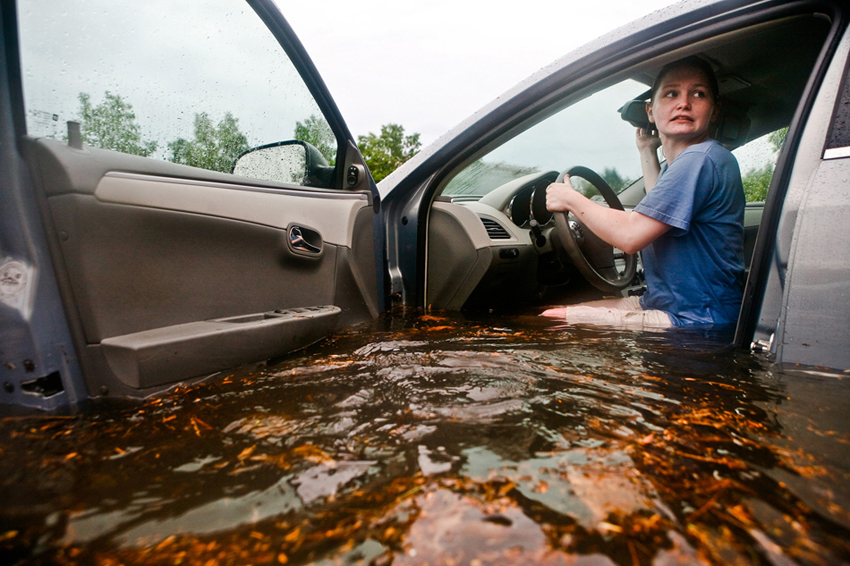
Flood, ©Tucker Walsh
Out of all the events and images in a recent Corcoran Gallery of Art e-newsletter, there was one photograph (shown above) that just totally engaged me. I had to know more about the image and the photographer. So I caught up with Tucker Walsh, a photojournalism student at the Corcoran College of Art & Design, currently in his sophomore year, to find out more about Flood and what it’s like to be a student these days. Walsh won first place in the amateur category for FotoWeekDC/Newseum’s FOTOBAMA Contest and his work was recently included in the Corcoran Undergraduate Juried Exhibition by Jose Dominguez. He is definitely someone to watch.
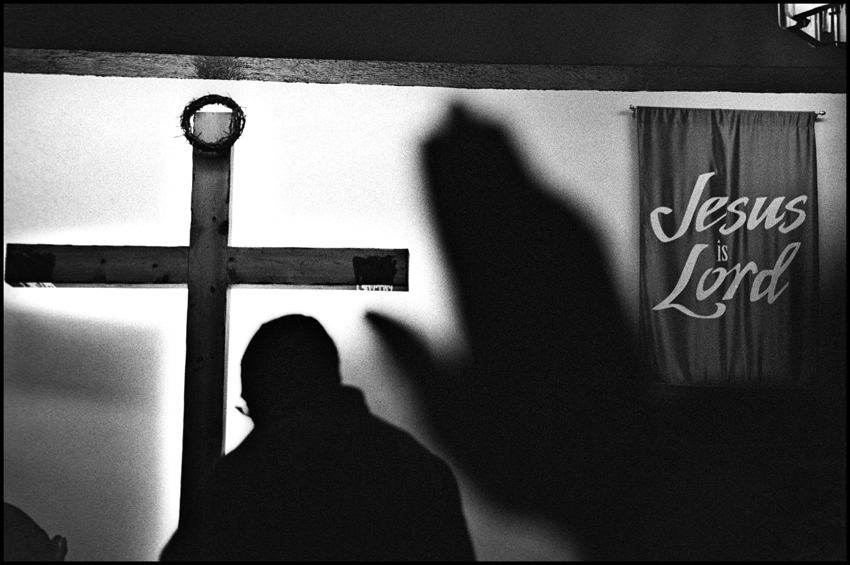
from Becoming a Man, ©Tucker Walsh
Larissa Leclair: How did you get into photography?
Tucker Walsh: I took a few basic photography classes in high school and a couple workshops during my summer breaks. When I was sixteen, I spent a month in Asia with Rustic Pathways on a trip that was geared towards young photographers. I would say that was when I first found my voice as a photographer.
LL: How is it being a student at the Corcoran?
TW: The Corcoran College of Art & Design, in the same building as the Corcoran Gallery of Art, is very small – around 400 students – which allows for lots of one-on-one attention with your professor. The best part is just living and learning in D.C.. I ride my bike past the White House every day to get to class. Talk about some good motivation!
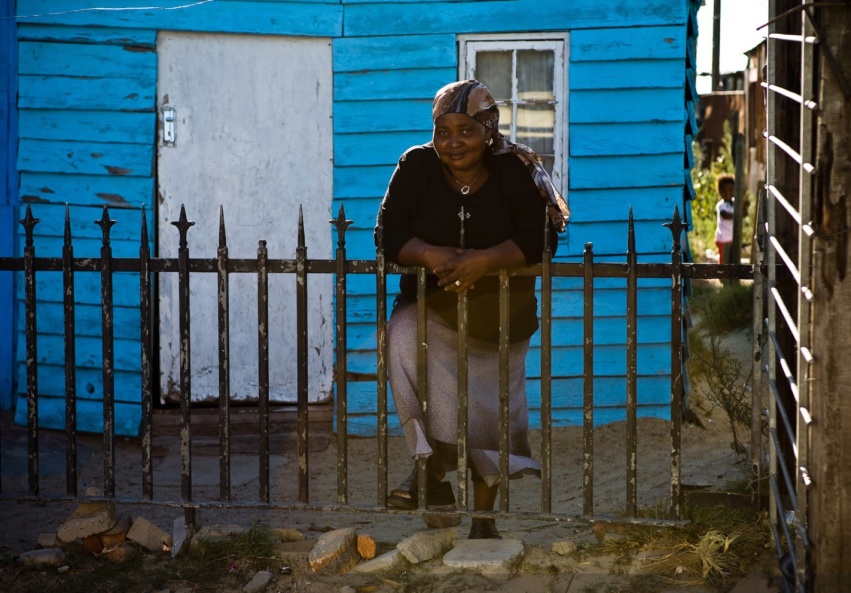
©Tucker Walsh
LL: I wonder if websites and blogs are integrated into your curriculum. Are there some that are required reading? Do professors encourage students to have a blog?
TW: This semester we were actually all assigned to create a Twitter account, so we could use social media’s power to communicate outside of class. I have come to really appreciate what something like Twitter can do. But overall, our professors mainly assign books and news articles to read. I would highly recommend Photojournalism by Ken Kobre. It’s basically the textbook for photojournalists. I have a blog. It is a lot of fun but also a lot more time consuming and stressful than I anticipated. I started it thinking I would put up photographs and work that wasn’t strong enough to be on my website but was still worth sharing with friends, family, or classmates. It’s now turned into basically a second website. I’m thinking about scrapping my website and just using the blog format as a work showcase. This would allow for much more viewer interaction, with commenting, social media, photo rating, etc.
LL: What blogs do you read?
TW: NYTimes Lens, NPPA’s Visual Student, Prof. Kobre’s Guide to Video Journalism, Multimedia Muse, PhotojournalismLinks.com, Burn Magazine, MediaStorm, Huffington Post, and NPR’s Picture Show.
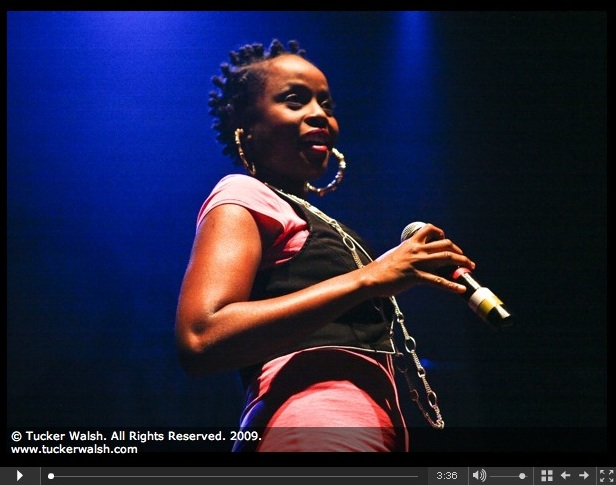
LL: On your website you call yourself a visual journalist. Why the distinction from photojournalist?
TW: Ultimately, I hope to produce long-term, web-based documentary projects that use still images, video, web design, graphics, text, audio, etc. to tell the story. When I think of photojournalism, I think of a single image on the front of a newspaper, or perhaps a six image picture story in a magazine, or even a two-minute audio slideshow on a newspaper website. My goal is to take a step back from the 24-hour news cycle and combine the visual brilliance of Ron Fricke with the quality storytelling and journalism of NPR. A good example of this is”Ian Fisher: American Solider.” Another example is Scott Strazzante’s “Common Ground” on MediaStorm. I find it is a more in-depth and rounded look at a story that we often only hear about in small pieces. So to answer your question, I think the name “visual journalist” is more open-ended and mindful of the changes that need to take place in the industry. But hey, it’s just a name!
LL: Okay, so tell me about the flood photo that made me track you down?
TW: I took the flood photo last summer while I was doing an internship at The New London Day newspaper in Connecticut. I talk about it on my blog. (Read the entry here.) I submitted that photo and two others to the annual Corcoran College Undergraduate Juried Exhibition, and I was honored to receive “First Place” for the flood image. Another photo of mine, from a Barack Obama rally, was also in the exhibit, along with some truly amazing work from other Corcoran students.
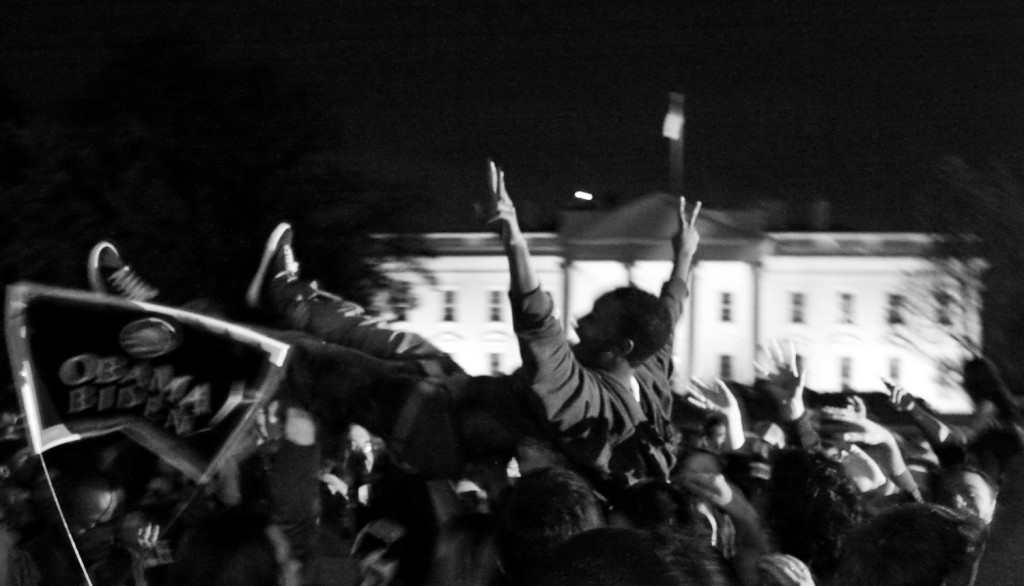
©Tucker Walsh, FOTOBAMA Contest winning image
LL: And tell me about the FotoWeek DC winning photograph (shown above).
TW: The photograph that won first place in the amateur/student category of FotoWeek DC’s “FOTOBAMA Contest” was taken on election night in front of the White House. My friends and I were all watching the numbers come in on CNN, and when the news broke that Senator Obama would become President Obama, we immediately jumped up, grabbed our cameras, and dashed down Pennsylvania Avenue to the White House. There was only about one hundred other college students there when we arrived. However, within half and hour’s time, there was well over a thousand people right in front of the White House, all of whom were going absolutely crazy, jumping up and down, dancing, singing, and screaming. It was also raining, which added to the insanity! I ended up staying down there till 4:30 am, snapping photos and taking in the pure joy that seemed to unite all of DC for a short period of time. The shot that won the FotoWeek contest was of an African-American man crowd surfing with two peace signs in the air directly in front of the White House. I was shooting with a wide angle lens at 3200 ISO with a Canon 20D, so the final image was very noisy, blurry, and cropped to correct a heavy tilt (I was taking photos while dancing). In a way, however, the quality of the image reflected my memory of the event. The whole night was a giant blur of craziness and celebration. I converted the image to black&white to give a sense of memory and timelessness. The winning images from the contest are currently up for display above the Crystal City metro stop.
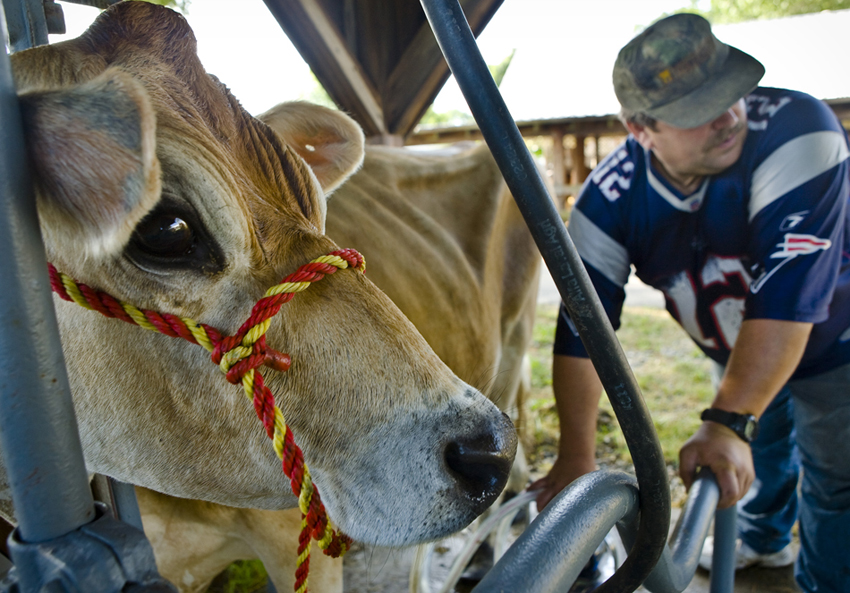
©Tucker Walsh
LL: What are you working on now?
TW: I am in the process of applying to Salt Institute For Documentary Studies in Portland, Maine. If accepted, I will spend my next fall semester there. Salt is a small, private institution that has three tracks: photography, radio, and writing. Students spend the entire semester documenting one photo story, as well as one story in collaboration with a writing student. I was born in Portland and consider myself a “Maineiac” at heart, so the idea of spending an entire semester documenting stories there really excites me!
LL: Last question, what photojournalists do you admire/follow?
TW: The bodies of work that inspire and motivate me on a daily basis are David Burnett’s “44 Days In Iran,” Pam Spalding’s “An American Family,” Edward Burtynksy’s “Oil,” Ed Kashi’s “Oil in Niger Delta,” Ernesto Bazan’s “Cuba,” and Jenn Ackerman’s “Trapt.” The list could go on and on…Ami Vitale, Adam Ferguson, Charles Ommanney, Jonas Bendiksen…Then there is Henri Cartier-Bresson, Sebastiao Salgado and James Nachtwey who are just magicians at what they do. Documentary films have also influenced me just as much still images have. Some that I would recommend to photographers are Grizzly Man, Baraka, Born Into Brothels, The Cove, War Photographer, Cry of the Snow Lion, and War Dance.
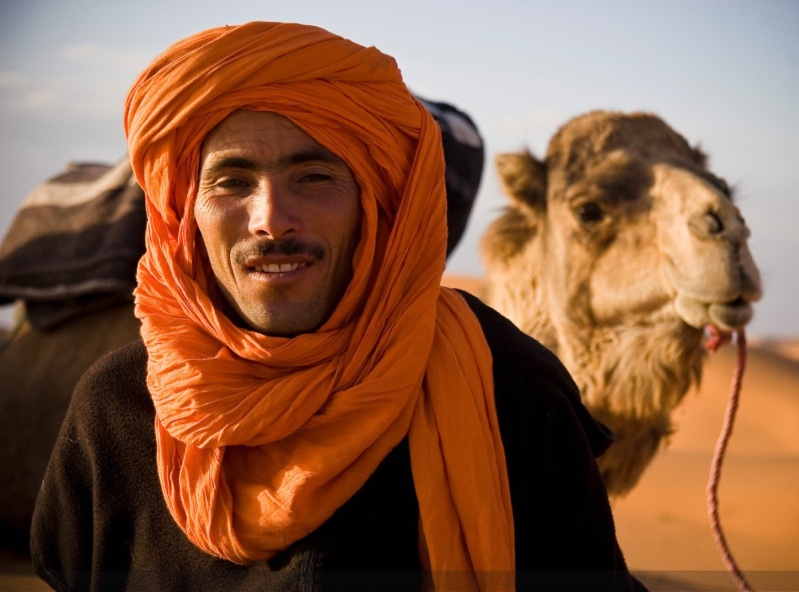
©Tucker Walsh
LL: Thank you Tucker.
Check out Tucker Walsh’s website and blog.
Follow Tucker on Twitter @PJ_Tucker.
March 10th, 2010
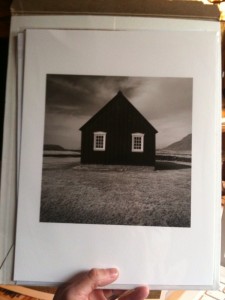
Love this image – “Black Church, Budir” from David Bram’s Iceland series. Just received it in the mail from wall space gallery in support of Doctors Without Borders and their relief effort in Haiti.
David Bram is a photographer and editor of Fraction Magazine. Check out Issue 12, the latest revamped online issue. “Achromatic” features black-and-white work from five female photographers – Susan Hayre Thelwell, Noelle Swan Gilbert, Isa Leshko, Celine Wu, and Francesca Yorke.
March 6th, 2010
 Bird Watching
Bird Watching
Photographs by Paula McCartney. Texts by Darius Himes and Karen IrvinePrinceton Architectural Press, New York, 2010
120 pp., 40 color illustrations, 8×10″
Paula McCartney has been making unique and limited edition artist books for many years. She sees the book as a medium and visualizes much of her photographic work in book form, many of her photographs exist only in the artist book. McCartney’s first trade edition, published by Princeton Architectural Press, will be welcomed by individual collectors interested in McCartney’s work, as it is both affordable in comparison to her artist books and beautiful. The monograph is an expanded version of her artist book Bird Watching and includes every image from the series. Mimicking a private field guide journal, McCartney takes the reader on the most successful bird watching quest, or so it seems at first glance.
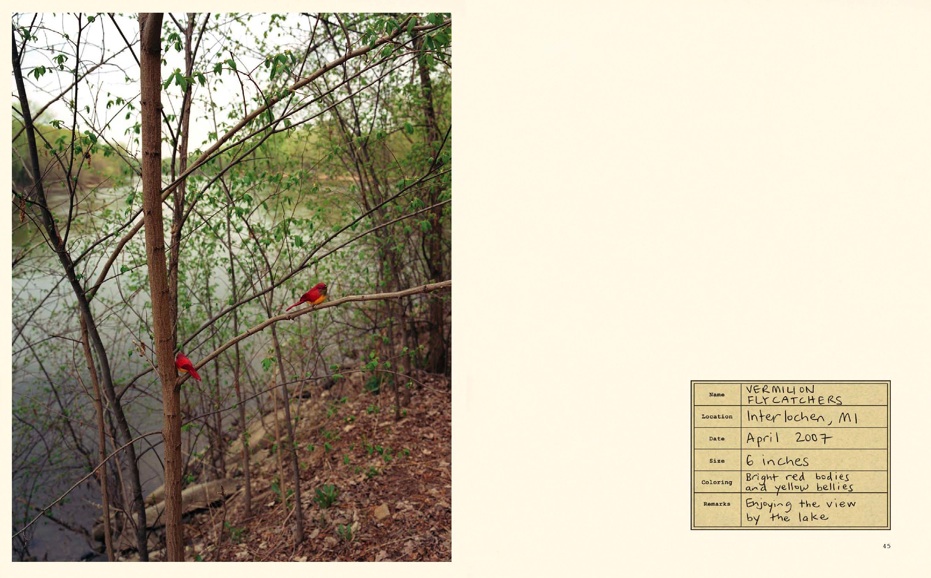
McCartney meticulously notes all the necessary details for credible bird watching – name, location, date, size, coloring and remarks. She also includes drawings, diagrams, plant specimens, a life list, and journal-like notes about her bird watching travels. What makes this book obviously much more than a personal field journal are the added elements of context – essays by Karen Irvine and Darius Himes, the playfully subtle references to the creative fiction McCartney has crafted (the map of “Migration Patterns of a Bird Watcher”), and, of course, the photographs. No bird watcher could ever capture what McCartney has captured in her images. McCartney set up her camera just feet away from the birds – an unrealistic closeness – as though she said, “Hey bird, stay right there. Let me take your picture. Could you move a little more to the left on that branch? Okay. Great. That’s the shot!” McCartney has taken the watching, the waiting, and the long lens out of bird watching to create stunning photographs of forests and brush with perfectly placed birds – and I do mean placed. McCartney has wired these birds to their branches in the real natural environment. As opposed to McCartney’s earlier series “Bronx Zoo” of real birds in constructed habitats, she reverses the elements, putting faux birds in the real environment and does so in a much more convincing way than pink flamingo lawn ornaments or deer statues on the woodland edge of a suburban lawn.
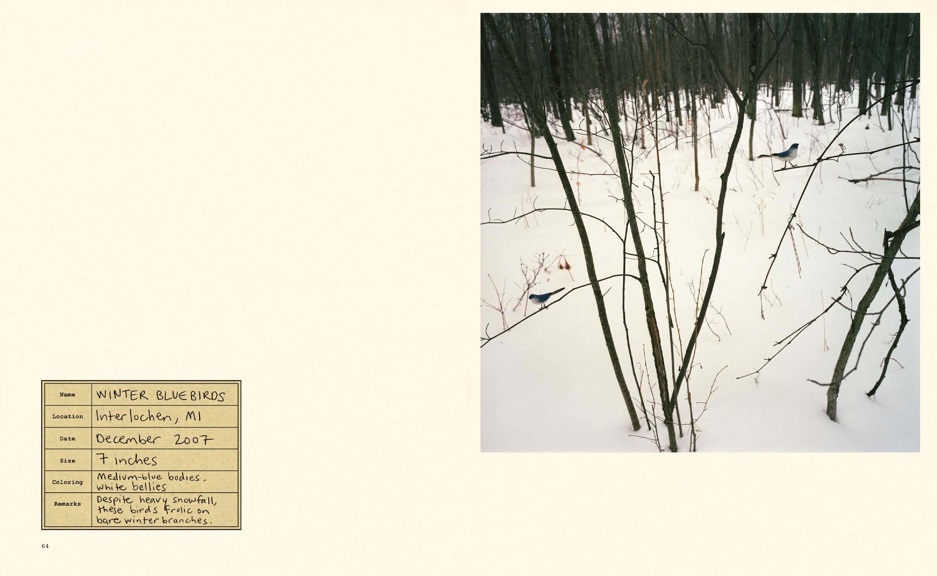
Realizing this forgery, I started to question many things in the book. Can one actually find a Northern Cardinal in Oregon at all? Are the plant specimens real? I am caught up in McCartney’s fictitious creation, but I don’t mind. I quietly observe the peaceful birds in what may or may not be their natural habitat, and find humor in the flatfooted Winter Bluebirds wired onto their tree branches. Unworldly skill would be needed for McCartney to have captured the exact transitional moment when a bird releases its grip from the branch before it starts to hop or fly away.
I’m not an armchair traveler but I am definitely an armchair bird-watcher with Paula McCartney’s Bird Watching, and I thoroughly enjoyed the experience.
Originally published in photo-eye magazine, March 5, 2010. Books can be purchased through photo-eye.
Bird Watching is on view at KLOMPCHING March 4-April 23, 2010; Paula McCartney and Darius Himes discussion and book signing March 6, 2010 from 1-2pm at the gallery. That’s today!
An interview with Paula McCartney about visualizing her work in book form and her journey in making the artist book Bird Watching into the trade edition is included in the forthcoming book Publish your Photography Book! by Darius Himes and Mary Virginia Swanson, also by Princeton Architectural Press, Fall 2010.
March 4th, 2010

Even though the Olympics are over, there is still time to see Go for Gold!; photographs by Gesche Würfel at Civilian Art Projects in DC. From the essay by Al Miner, assistant curator at the Hirshhorn, Würfel’s two series on view Go for Gold! and Farewell from the Garden Paradise “deliver visual eulogies for East London’s Lower Lea Valley. With the eye of a trained urban planner and the lyrical lens of her camera, Würfel examines dormant spaces caught between a residential past and a grand future as sites for the 2012 Summer Olympic Games…. Gesche Würfel’s work tells not of the competition between athletes, but rather between urban generations and, indirectly, between cities that vie for the wealth and power of hosting the Olympics.” The exhibition is on vie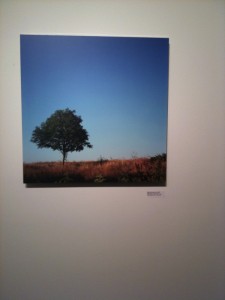 w until March 20, 2010.
w until March 20, 2010.
Go for Gold!
February 19-March 20, 2010
Civilian Art Projects
1019 7th Street, NW
Washington, DC
202.607.3804
Hours: Wednesday & Saturday 1-6pm, Friday 4-8pm
Director: Jayme McLellan
March 3rd, 2010
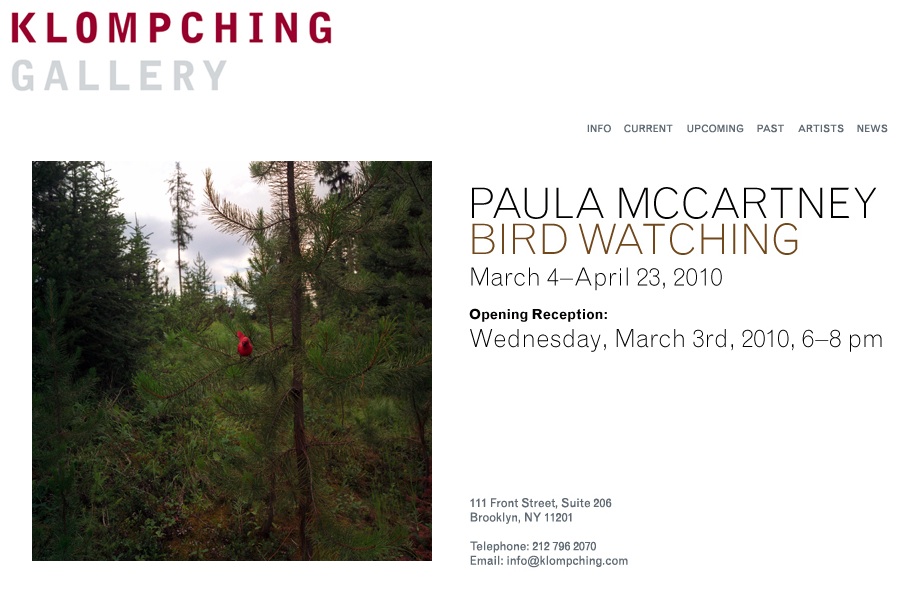
Head over to KlompChing Gallery tonight for Bird Watching (and people watching) from 6-8pm. About her work, Paula McCartney says, “[r]ather than settling for what nature has to offer, I have taken control and adorned the trees with their longed for, but absent, tenants.” The truth is in the details. Look closely.
And don’t miss the discussion and book signing with Paula McCartney and Darius Himes on Saturday March 6, 2010 from 1-2PM. Bird Watching is published by Princeton Architectural Press and is based on McCartney’s artist book of the same name.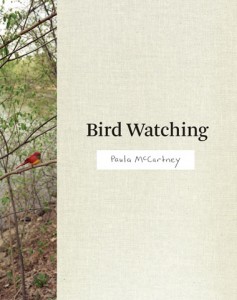
Related posts: Book Review: Bird Watching by Paula McCartney.
March 2nd, 2010
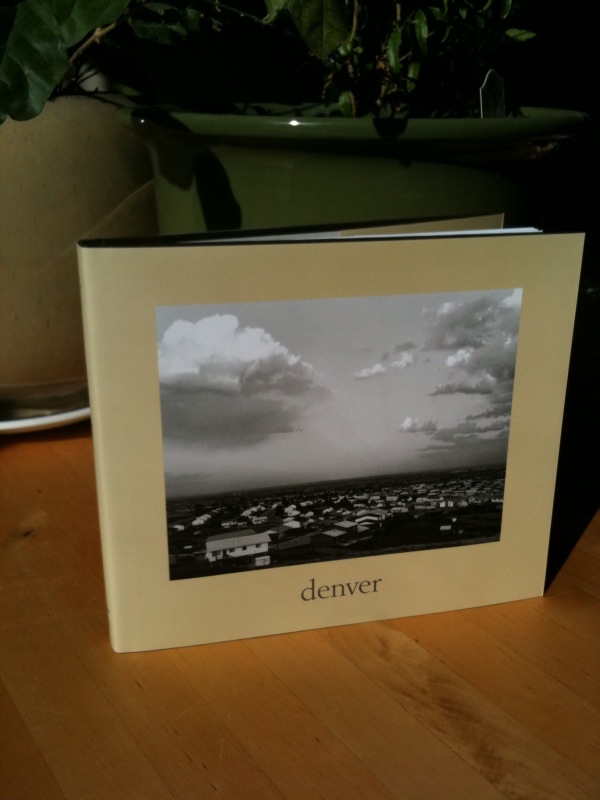
In homage to the stack of books on my desk and the amazing “Stacks” at Yale University Library, I’m starting a new feature on my blog, “From the Stacks,” where I will post a book from my collection.
Today is denver by Robert Adams (Yale University Art Gallery, 2009). denver is a revised edition of the original, published in 1977 by the Colorado Associated University Press in cooperation with the State Historical Society of Colorado. Quoting from the publisher’s description, “denver and What We Bought, together with The New West, form a loose trilogy of Robert Adams’s work exploring the rapidly developing landscape of the Denver metropolitan area from 1968 through 1974.” Yale University Art Gallery has in its collection Robert Adams’ complete body of work and is organizing a major traveling retrospective that begins later this year. On view now until April 17 at Matthew Marks Gallery in NYC is Summer Nights, Walking, one of my favorite bodies of work by Adams.
Thank you Joshua Chuang for the book.






















 Bird Watching
Bird Watching


 w until March 20, 2010.
w until March 20, 2010.

